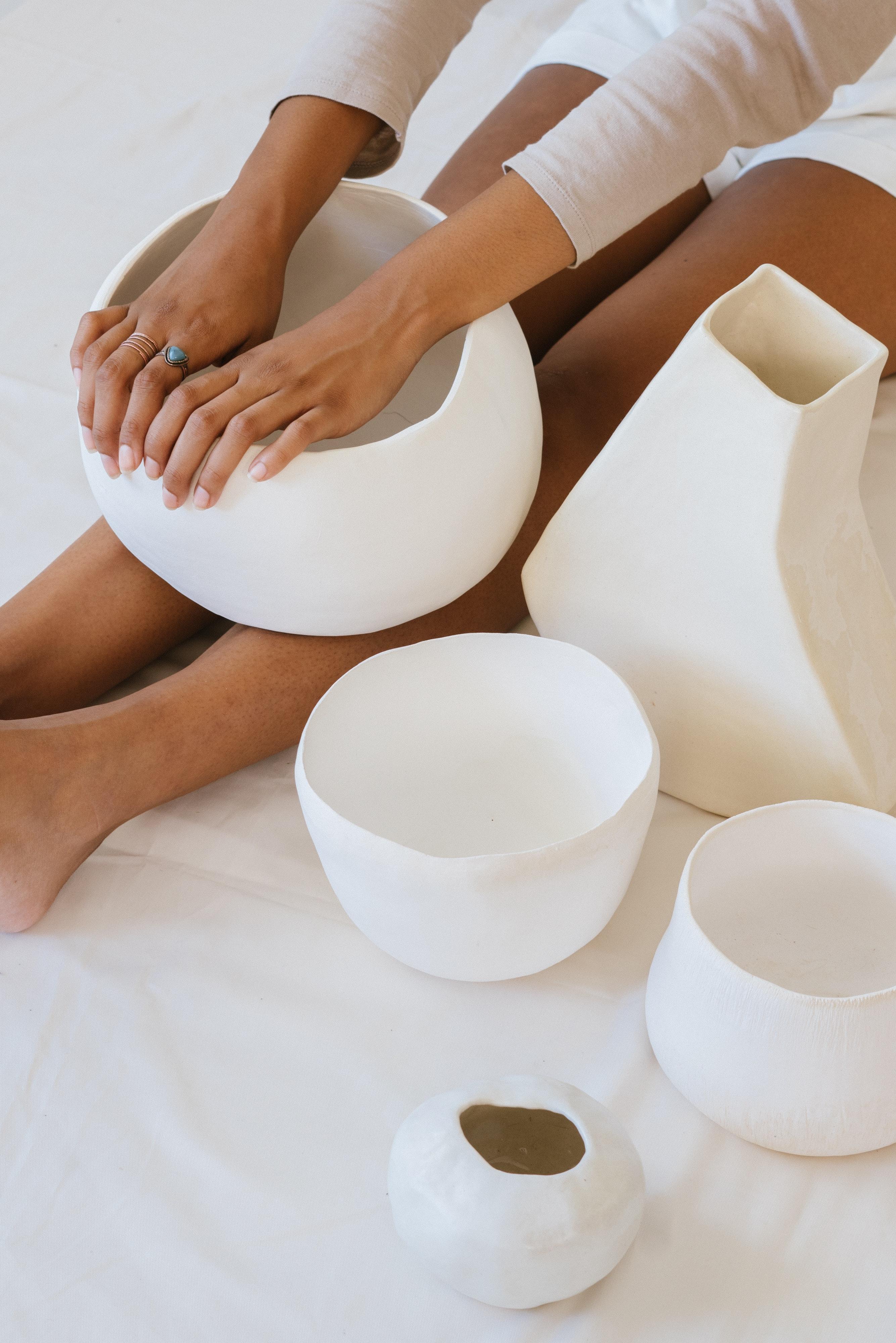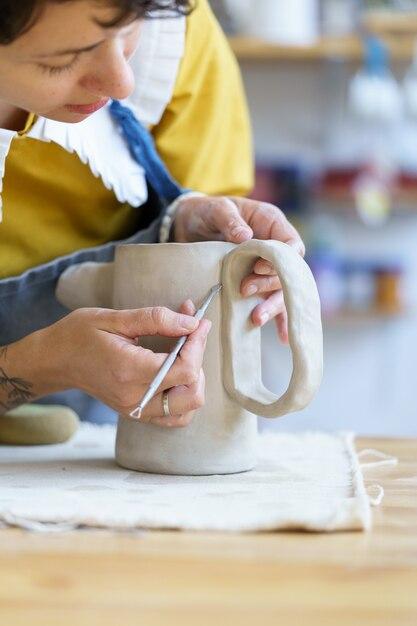Welcome to our informative blog post on the fascinating world of ceramics! If you’ve ever been curious about what slabs mean in ceramics, you’ve come to the right place. Whether you’re a novice or an experienced artist, understanding slabs and their applications can enhance your ceramic projects.
Ceramics, in its simplest definition, refers to objects made from clay that are permanently hardened through processes such as firing. Within the realm of ceramics, there are three basic types: earthenware, stoneware, and porcelain. But today, we’ll delve into the concept of slabs and their significance in ceramic art.
So, what exactly are slabs in ceramics? Slabs are flat, rectangular pieces of clay that have been rolled out to a consistent thickness. This versatile form of clay can be used as a starting point for various techniques in ceramic construction, offering endless possibilities for creative exploration and functional design.
Join us as we explore the process of creating ceramic slabs, the techniques involved in slab building, and the countless artistic endeavors that can be achieved using this method. Get ready to unleash your creativity and discover the beauty of slab-based ceramics!
What Does Slab Mean in Ceramics
The Basics of Slab Building
When it comes to ceramics, “slab” doesn’t refer to a tasty piece of bread or a flat stone you might find skipping across a pond. In the world of pottery, a slab is a sheet of clay that has been rolled out to a consistent thickness. This technique is commonly used in hand-building ceramics, which is the process of shaping clay without using a potter’s wheel.
Rolling with the Clay
To create a slab, potters use a rolling pin or a slab roller, which is like a mini steamroller for clay. By rolling the clay back and forth, they ensure an even thickness that is perfect for creating various forms. It’s like having a personal fitness trainer for your clay – giving it a good workout, making it strong and pliable. Who knew clay could benefit from the gym?
Slabs: The Clay Artist’s Canvas
Once the slab is rolled out, it becomes a versatile canvas for the clay artist’s imagination. The flat surface is excellent for creating tiles, plates, boxes, and even sculptures. It allows artists to easily cut and shape the clay to achieve their desired forms. It’s like playing with oversized clay pancakes – minus the butter and syrup, of course.
Coil, Schmoil – Go Slab!
Although coiling is another popular method in ceramics, slab building provides unique opportunities for creativity. You can layer slabs on top of one another to create depth and texture, or you can fold and bend them to add interesting angles or curves to your piece. The possibilities are endless with slabs; it’s like playing a never-ending game of clay Tetris, except you’re the designer.
Tips and Tricks for Slab Success
Working with slabs can be a lot of fun, but there are a few things to keep in mind. Firstly, make sure your clay is the right consistency for rolling. It should be firm enough to hold its shape but not so dry that it cracks. Secondly, use canvas or a piece of fabric when rolling out your slabs to prevent them from sticking to the table. Lastly, don’t shy away from experimenting with different textures, patterns, and techniques to make your slabs stand out. After all, creativity should run amok in the ceramics studio!
Slab it Like a Pro!
So, the next time you find yourself in the world of ceramics, don’t be surprised if someone mentions slabs. Now, you know that it’s not about concrete flooring or gourmet bread – it’s all about rolling out sheets of clay for sculpting and creating unique ceramic pieces. Embrace the slab technique and let your creativity soar as you mold and shape this clay canvas into magnificent art. Who knew art could be as flat as a pancake?
FAQ: What Does Slab Mean in Ceramics
Can You Do Ceramics at Home
Yes, absolutely! Ceramics can be practiced both in professional studios and in the comfort of your own home. All you need is a designated space, some basic equipment, and of course, your creativity. So go ahead, unleash your inner potter!
What Are the Three Basic Types of Ceramics
The three basic types of ceramics are earthenware, stoneware, and porcelain. Each type has its own unique characteristics and firing temperatures. Earthenware is known for its porous nature and lower firing temperature, while stoneware is stronger and more durable. Porcelain, on the other hand, is known for its delicate and translucent appearance.
What Are Slabs in Ceramics
In ceramics, slabs refer to flat pieces of clay that are made by rolling out the clay with a rolling pin or using a slab roller. Slabs are versatile and can be used to create various forms such as plates, bowls, tiles, and even sculptural pieces. Working with slabs allows for more design possibilities and enables artists to explore their creativity.
What Are Slabs Made Of
Slabs in ceramics are made of clay. The type of clay used depends on the desired result and the firing temperature. Different clays have different qualities, like color, texture, and shrinkage rate. Some common types of clay used for slabs include earthenware, stoneware, and porcelain.
What Does Ceramic Mean
Ceramic is a term that encompasses a wide range of materials and objects made from clay, which are then fired at a high temperature in a kiln. Ceramic objects can be functional, decorative, or both, and have been a part of human culture for thousands of years. From pottery to tiles, ceramics are an essential part of our daily lives.
How Do You Make Ceramic Slabs
Making ceramic slabs is a straightforward process. First, start with a piece of clay and use a rolling pin or a slab roller to roll it out to the desired thickness. Make sure the slab is even and free of any air bubbles or cracks. Once you have your slab, you can cut it into the desired shape using a template or a pottery knife. Don’t forget to smooth any rough edges before further manipulation.
How Is Slab Building Done
Slab building is a technique in ceramics where flat pieces of clay are joined together to create three-dimensional forms. To begin, cut your clay slab into the desired shapes and score the edges with a ceramic tool. Apply slip, which is a mixture of water and clay, onto the scored edges to act as a glue. Then, carefully press the scored edges together, making sure they are securely joined. Allow the piece to dry before further refinement or decoration.
What Does “Score” Mean in Ceramics
In ceramics, scoring refers to the process of making shallow cuts or scratches on the surface of the clay. Scoring is done to create a rough texture, which helps pieces of clay adhere to each other when joined together. It provides a better surface for slip to grip, resulting in stronger and sturdier connections.
What Can You Do with a Slab in Ceramics
With slabs in ceramics, the possibilities are endless! You can create functional items like plates, bowls, vases, and cups. Alternatively, you can let your imagination run wild and use slabs to construct sculptural forms, wall hangings, or even abstract art pieces. Let your creative juices flow and explore the limitless potential of slab building.
What Are Slabs in Art
In the art world, slabs refer to flat pieces or sections of material that are often used as a foundation or canvas for various artistic endeavors. In ceramics specifically, slabs are widely used as a starting point for creating clay sculptures, tiles, and other art forms. They provide artists with a versatile and malleable medium to express their artistic visions.
What Is Soft Slab Ceramic
Soft slab ceramic is a technique used in ceramics where the clay is rolled out into thin, flexible sheets. These soft slabs can be manipulated and formed into intricate shapes before being assembled into a final piece. Soft slab ceramic allows for more organic and flowing forms, adding a touch of flexibility and freedom to the creative process.
How Thick Should Clay Slabs Be
The thickness of clay slabs largely depends on the desired outcome and the type of clay being used. As a general guideline, clay slabs for functional pottery items like plates and bowls are typically around ¼ inch to ½ inch thick. However, for larger sculptural pieces or tiles, thicker slabs may be necessary to maintain structural integrity.
How Much Weight Can a 4-Inch Slab Hold
A 4-inch slab of clay can hold significant weight, assuming it has been properly constructed and fired to maturity. While the specific weight-bearing capacity varies depending on factors like clay type and firing technique, a well-made 4-inch slab can support heavy loads such as a sculpture or part of a larger ceramic structure.
Can I Pour a 2-Inch Concrete Slab
No, pouring a 2-inch concrete slab would not be sufficient for most standard construction requirements. Concrete slabs are typically poured at a minimum thickness of 4 inches to provide adequate strength and durability. Thinner slabs may be prone to cracking and lacking the necessary structural integrity.
How Thick Should a Concrete Slab Be for a Garage
For a garage, it is recommended to pour a concrete slab with a minimum thickness of 4 inches or more. The thickness depends on the weight it will bear, such as vehicles and storage items. A thicker slab ensures sufficient support and durability to withstand the weight and daily usage demands of a garage.
What Is the Difference Between Coil and Slab Processes
Coil building and slab building are two popular methods in ceramics, both offering unique creative possibilities. Coil building involves rolling or extruding clay into long, snakelike coils, which are then stacked and joined together to create a form. Slab building, as discussed earlier, utilizes flat pieces of clay that are cut, scored, and assembled to construct various shapes. While both methods offer versatility, coil building often results in more organic and curvaceous forms, while slab building offers cleaner, geometric designs.
What Is the Slab Technique
The slab technique in ceramics refers to the process of creating three-dimensional forms by joining flat slabs of clay together. It involves cutting the clay into the desired shapes, scoring the edges to create texture, applying slip as a bonding agent, and carefully joining the pieces together. The slab technique allows for precise control over form and structure, making it a popular choice among ceramic artists.
What Is the Throwing Method in Ceramics
The throwing method in ceramics is the process of creating pottery on a potter’s wheel. It involves shaping clay by applying pressure and movement with hands and tools while the wheel spins. This technique allows the potter to create symmetrical and functional forms such as bowls, cups, and vases. The throwing method offers a dynamic and hands-on approach to pottery making.
What Does “Coil” Mean in Ceramics
In ceramics, a coil refers to a long, thin piece of clay that has been rolled into a spiral or snakelike shape. Coiling is a technique where these clay coils are stacked and joined together to create a larger form. By building up walls with coils, artists can create unique vessels, sculptures, and even elaborate architectural structures.
How Thick Should a Slab Be
The thickness of a slab largely depends on the desired outcome and the specific requirements of the project. As a general rule of thumb, slabs for functional ceramic pieces like plates and bowls are usually around ¼ inch to ½ inch thick. However, for larger or more structural pieces, thicker slabs may be needed to provide the necessary strength and stability.
End of Subsection

